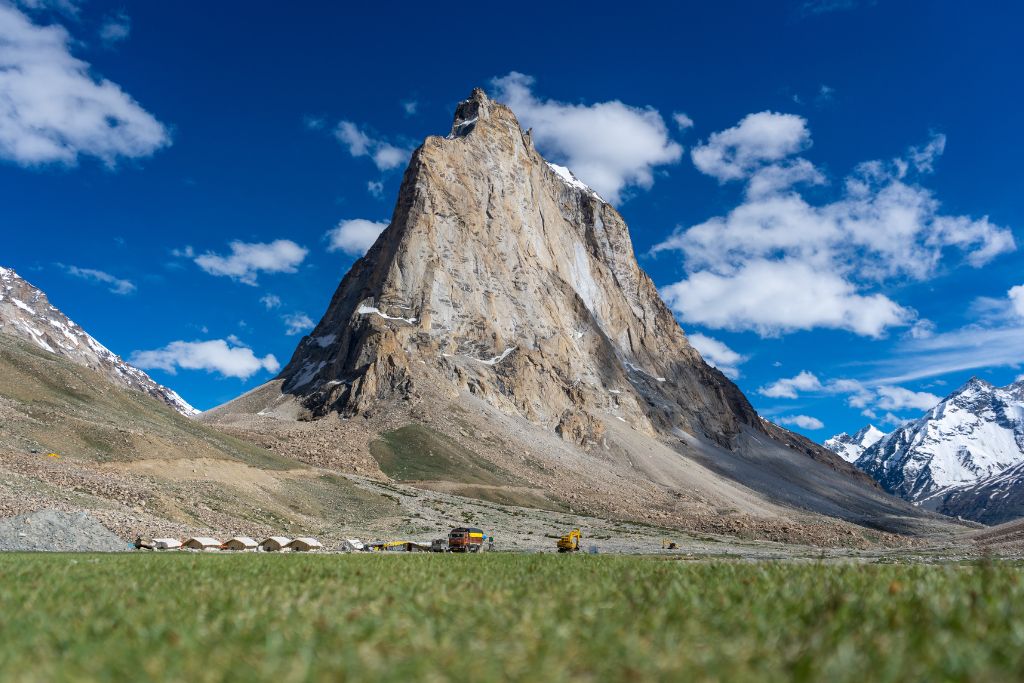
Gonbo Rongjon: The mountain where people see God
While Tibetan Buddhists of Zanskar Valley hold the mountain in high spiritual regard, many trekkers and adventurists come simply to experience its grandeur. At 5,520 metres, Gonbo Rongjon is impossible to miss in the remote valley.
Gonbo Rongjon translates to “Gonbo’s Throne,” a reference to the revered Buddhist deity Gonbo (Mahakala). According to local legends, the mountain is believed to be the abode of Gonbo, and is considered a sacred site where pilgrims come to seek blessings and meditate.
The mountain is located approximately 16 km south of Kargyak, the first village in Zanskar after crossing Shinkula (“la” means pass in Tibetan), the mountain pass that separates Himachal Pradesh from Ladakh.
It is a standalone mountain, reaching a height of 5,520 metres, with its base located at around 4,500 metres. Climbing the mountain peak is prohibited due to its deep religious significance. However, rock climbers do come for an adventure here.
In recent years, Gonbo Rongjon has seen a notable increase in tourism. A few dhabas and tented accommodations have been established, with “Acho Camps” emerging as the most popular choice among visitors. Earlier, the region was mainly frequented by foreign trekkers, but now it attracts a wider range of tourists.
Acho Camps was founded in 2021 by Stanzin Nantak and his wife, Sonam Choszom, after the COVID-19 lockdown. Stanzin hails from Haing village, located about 20 km from the camp’s site, while Sonam is from Itcher, home to the renowned statue of the Maitreya Buddha.
The accommodation at Acho Camps is priced at ₹1500 per person, which includes both breakfast and dinner. The camp offers simple vegetarian meals, along with eggs. Additionally, guests have the option to set up their own tents within the camp’s compound for a nominal charge.
It is widely believed by the locals that a few fortunate individuals are blessed with the rare opportunity to witness the face of God. Some claim to have seen the face of Buddha, while others report glimpses of Hindu deities such as Ganesha or Shiva.
The region offers an ideal location for astrophotographers. The best time to catch a glimpse of the Milky Way and visit Gonbo Rongjon is between mid-June to September. Stanzin himself is an expert at locating the galaxy and is always eager to assist fellow enthusiasts.
There is no mobile network coverage throughout the entire Zanskar region. However, a JIO postpaid SIM card issued specifically in Ladakh and J&K will provide network service starting from Kargyak onwards.
Also known as the ‘golden mountain’, Gonbo Rongjon is also experiencing rockslides, a sign of increasing fragility of the Himalayas. Due to the road construction of the Nimmu-Padum-Darcha route, the mountain can be accessed by road, the experience of which was earlier available to only avid trekkers who explored the region by foot.
Gonbo Rongjon is clearly visible from Kargyak village but gradually disappears from view as the road winds further north towards Padum, the main town in Zanskar Valley. But sustainable tourism is the need of the region as more tourists means more waste. For an ecologically fragile ecosystem such as the Transhimalayas, this can have high negative implications.
The lead image shows Gonbo Rongjon, the sacred monolith mountain standing tall at 5,520 metres in the remote Zanskar Valley.
Photography and reporting by Atiqur Rahman, a Delhi-based photographer who hails from Nagaland.










